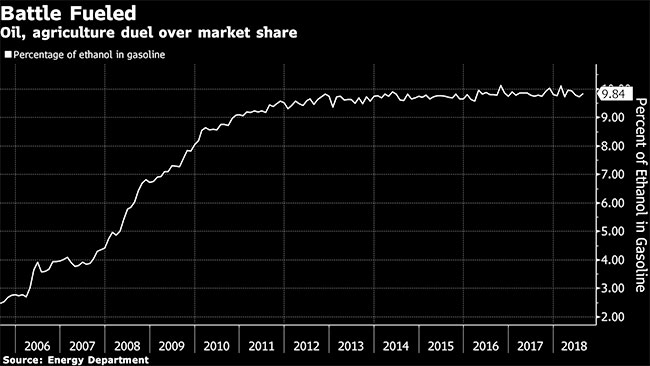EPA Said to Hold Biofuel Quotas for Gasoline Steady for 2019

The Trump administration is set to order refiners to use 15 billion gallons of conventional renewable fuels such as corn-based ethanol next year, resisting oil industry pressure to lower the mandate, according to three people familiar with the plans.
The slate of biofuel blending targets set to be released Nov. 30 will be in line with quotas the Environmental Protection Agency proposed in June, said the people, who asked not to be identified discussing the matter before an official announcement.
The quotas are unlikely to satisfy agricultural leaders and their political allies who have angrily denounced EPA’s move to exempt some small refineries from the mandates. Under the U.S. Renewable Fuel Standard law, small facilities facing a “disproportionate economic hardship” can win waivers from the annual biofuel blending requirements, and so far, 15 refineries have applied for relief from the 2018 quotas.
EPA had proposed requiring refiners to blend 19.88 billion gallons of biofuels next year, a 3.1% increase over current quotas. That target included a 15 billion-gallon quota for conventional renewable fuels such as corn-based ethanol, the maximum allowed under federal law and the same amount required in 2018. The agency also is set to finalize a 2020 requirement for using biodiesel that typically is made from soybeans, after proposing a 15.7% increase in the target.

EPA is not set to adjust the final quotas to account for exemptions expected in 2019, according to two of the people familiar with the matter. Representatives of EPA didn’t immediately respond to a request for comment.
In releasing the final biofuel quotas, the Trump administration will be kicking off a broad overhaul of the Renewable Fuel Standard program, setting off a fresh battle between the oil industry and agricultural interests over the biofuel mandate that Congress created in 2005.
Congress envisioned refiners would use some 36 billion gallons of biofuel in 2022 and expected that over time, conventional, corn-based ethanol would give way to next-generation advanced biofuels made from switchgrass, algae and other nonedible materials. But cellulosic biofuel has been slow to commercialize, with actual production lagging well bellow the congressional targets.
EPA has said it plans to establish new biofuel blending targets for 2020 through 2022 as part of the coming RFS “reset.” And the agency is poised to ratchet down ambitious congressional goals for cellulosic biofuels as part of that process.
Oil industry leaders said they view the agency’s RFS reset as a chance to recalibrate a program created under vastly different market conditions 13 years ago, when lawmakers were eager to wean the U.S. off foreign sources of oil and develop home-grown alternatives. Efforts to revamp the program in Congress have been stymied for years because of tensions between the oil industry and the agricultural sector.
Separately, EPA is moving to write a new regulation lifting summertime fueling restrictions on gasoline containing up to 15% ethanol, in keeping with a pledge President Donald Trump made to Iowa voters in October.




